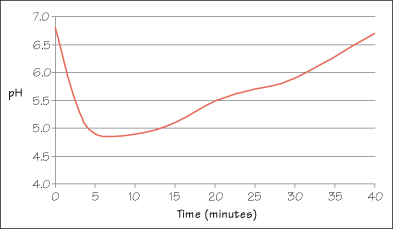15
Cariology
Current Understanding of Cariology
Acidogenic Theory
Miller proposed the chemoparasitic theory for the process of dental caries in 1890 which is now commonly known as the acidogenic theory of caries aetiology. The main features of the caries process are:
- fermentation of dietary carbohydrates by microorganisms in plaque to organic acids on the tooth surface;
- rapid lowering of the pH at the enamel surface to below the critical pH (5.5) at which enamel will dissolve;
- following plaque microbial metabolism the pH within plaque will rise due to the outward diffusion of acids and buffering so that remineralisation of enamel occurs;
- demineralisation and remineralisation is an equilibrium so that dental caries progresses only when demineralisation is greater than remineralisation.
Cavitation and Subsurface Demineralisation
Dental plaque forms on tooth surfaces when tooth brushing is stopped for a few days. Microorganisms comprise 70% of plaque and initially have cocci and then filamentous organisms as the plaque ages. Mutans streptococci are much more numerous when the diet is rich in sugars and fermentable carbohydrates which are metabolised to acids. The early carious lesion of enamel is subsurface with most of the mineral loss beneath a relatively intact enamel surface. The intact surface layer in enamel caries is due to dental plaque acting as a partial barrier to diffusion.
Mechanisms of Demineralisation and Lesion Progression
Robert Stephan researched plaque pH using microelectrodes before, during and after consumption of various foods and drinks. He plotted plaque pH versus time which is now known as a Stephan curve (Fig. 15.1). Within a couple of minutes of rinsing with a 10% sugar solution the plaque pH falls from about 7.0 to near pH 5.0 taking about 30–40 minutes to return to its baseline value. Below pH 5.5 demineralisation of enamel occurs (critical pH).
Figure 15.1 A typical Stephan curve showing the plaque pH response to a 10% glucose solution rinse.

The clinical appearance of these early lesions is well/>
Stay updated, free dental videos. Join our Telegram channel

VIDEdental - Online dental courses


